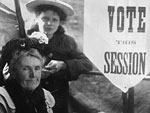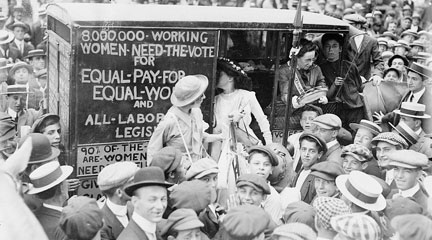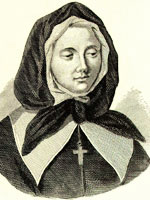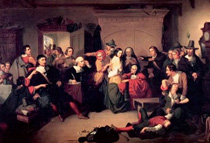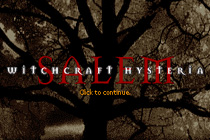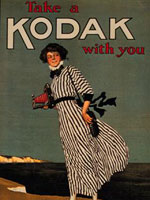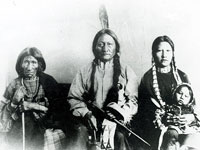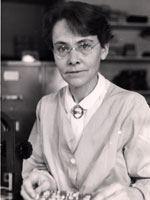The source comes from the Cherokee Nation's Supreme Court Records. In 1833, a lady named Molly Hightower claimed that a woman named Chickaua, who is the primary person mentioned in the document, that Chickaua and her sons belonged to Molly Hightower. And this claim was based on a transaction between another man named Sam Dent, to Molly Hightower's father. Sam Dent had been married to a Cherokee wife some time prior to the Revolutionary War, and he actually beat and killed his Cherokee wife. According to the Cherokee Law of Blood, the Deer clan sought revenge on Sam Dent for the death of their family member, because his wife had been a Deer clan member. And instead of subjecting himself to Deer clan punishment, he purchased a slave named Molly, who then became Chickaua, our main character in this document, to replace his dead wife. So, he gifted the Deer clan with the slave that he had purchased as a way of meeting his obligation for killing his wife.
The Deer clan adopted the slave named Molly, gave her the name Chickaua and, as the document says, she has by herself and descendants, been ever since recognized by said Nation, the Cherokee Nation or clan, the Deer clan, as a Cherokee. That's what allowed her sons to then also be members of the Deer clan and full-fledged members of the Cherokee Nation.
So, then later on, in 1833, Molly Hightower comes into the picture and says that Sam Dent sold Chickaua to her father, and that she actually owns Chickaua and Chickaua's descendants, Chickaua's sons. As the document says, "Her father was also an Indian trader who lived many years near the descendants of Chickaua and who never advanced or set up any claim to Chickaua and her son, Cunestuta," who is also called Isaac Tucker in the document. And this document is interesting, because it has a number of different names. You have English names, you have Cherokee names, you have a variety of different identities that are represented in the one document, in addition to this interesting transaction over slave property.
The Deer clan objected to Molly Hightower's claim, and decided to petition the Cherokee Supreme Court to prevent the return of Chickaua and her son, Cunestuta, to slavery. The Deer clan petitions them to, "Resist this oppression and illegal wrong attempted to be practiced on our brother and sister by the Hightower, Molly Hightower, in carrying into slavery two of whom have ever been and considered Native Cherokee." So, what that particular statement represents is an affirmation by the Deer clan that Molly is their kin, that Chickaua, Molly-slash-Chickaua, is their kin and belongs to them. It's really an affirmation of the adoption process and how seriously the Cherokees took their Law of Blood to bring in someone who had been an outsider to their community, and adopting them, making them full-fledged family members and not wanting them to return to the condition of slavery.
Ultimately, the document indicates that the Supreme Court sided with the Deer clan, saying that since Chickaua's adoption she has, quote, "continued in the Nation and enjoyed the liberty of freedom and that her two sons, Edward and Isaac Tucker, were born at the beloved town called Echota on the Tennessee River"—that was one of the main towns of the Cherokee Nation, what they call their beloved town—"and has ever been free and resided in the Nation."
Well, it's a very rich document on a number of levels. The primary thing that strikes me about it is the confusion over names. When you read it the first time, you're not sure who's who and who's talking about who. There's two Mollys. There's sort of what I think of as the first Molly, who was bought by Sam Dent, the trader, and then given to the Cherokee Deer clan. Her name then becomes Chickaua, and that's how she's referred to throughout the rest of the document. The next Molly is Molly Hightower, she who claims that her father actually owns Chickaua and Chickaua's descendants.
But there's—the fact that Chickaua obtains her name after her adoption into the Cherokee Nation, also means that her personal name is a marker of affiliation with a state, with a nation and a state, the Cherokee state. So, it's a great example of how names can mean many different layers of identity.
Another thing that we see in the document is how racial identity is shifting. We think of slaves as being of African descent, and we don't know, of course, that Molly, who became Chickaua, was not of African descent. In fact, we presume that she was. So, her identity shifts from being a black slave to an Indian free person, although obviously she herself does not change. It reminds us of how racial identity is constructed, how it has a history by itself that's worth examination.
Clan membership in Cherokee society, in many southeastern Native societies, was matrilineal, so you were only affiliated with the group through your mother's line. It's that matrilineal line that affirms everything about Cherokee identity and also Cherokee law.
This Law of Blood was based on the idea that clan members could avenge the deaths or other incidents happening to their kin, and women often made the decisions about how those deaths were to be avenged. And it was a way of making sure that people in Cherokee society lived in harmony with one another, because it was very clear what the consequences would be if you committed such a violent act.
Just because Chickaua escaped re-enslavement here doesn't mean that she was forever secure, because 1833 was a very critical time in the history of Indians in the southeast and well, indeed the whole nation. What we now know of as the old South, the sort of cotton culture of the antebellum South, would not have been possible without Indian removal, and the race relations, the intensity of black/white relations that developed prior to the Civil War, would have been very different had Indians remained in the southeast. This case is coming at a critical time, not just for the Cherokee Nation, but for questions of racial formation in the United States.
You don't understand very much about Cherokee removal from this particular source, but when you look at the date that Molly Hightower makes this claim in 1833 (October 18, 1833, is when the Supreme Court ruled on it), that date by itself triggers for the historian, a whole set of associations around the tensions of Cherokee removal, and the kinds of decisions that Congress was making, that President Andrew Jackson was making, that the Cherokee principal Chief John Ross, and the Cherokee General Council were making, around these issues of removal.
Because it is a fairly complex document, I introduced it to the students simply by asking them to identify the different names and to do a little genealogy of who the players are and how they're related to one another. So, on the one side they have Molly Hightower, they have Molly Hightower's father. On the other side, they have Sam Dent. They have his Cherokee wife. They have his purchase of Molly, the slave. Molly the slave then becomes a Cherokee.
The idea of tribes and nations that we operate with today when we talk about Native Americans, didn't always exist in its current form. What we see in this document is a world in which family, clan membership, kinship affiliation, was kind of the dominant logic of the society, and to understand that dominant logic you have to understand the names, and you have to understand the relationships. So, it's sort of a window into not only the time period, but also a method of doing history that speaks to the power of history itself, how it helps us understand another society that's different from our own.
I think students, they ask, they assume that because Sam Dent was a white man that he would have felt no responsibility to the Deer clan, that he would have felt no sense of loyalty or allegiance to the Cherokee Nation. But, I think what they need to understand is that the reality at this time was very different. Sam Dent made his living off of trading with Cherokee people, and under—most English traders understood that in order to trade with an Indian Nation, you had to have a kinship affiliation with that Nation. So, that's probably why Sam Dent married a Cherokee, was that his marriage to that woman enabled him, in fact, to make a living.
And one of the things that we feel we understand about American society is that whether right or wrong, European Americans have held the balance of power firmly in their hands over time, and this document is an example of a time period in which European Americans were not holding the balance of power. In fact, Cherokees at this time and place, certainly the time and place in which Sam Dent made these decisions, were holding the balance of power. This document reminds us how the Cherokee Supreme Court was alive and well. It was doing its job and acting on behalf of the Cherokee Nation, without regard to the United States and to the property laws of the United States that might have legitimized Sam Dent's sale to Molly Hightower's father.

